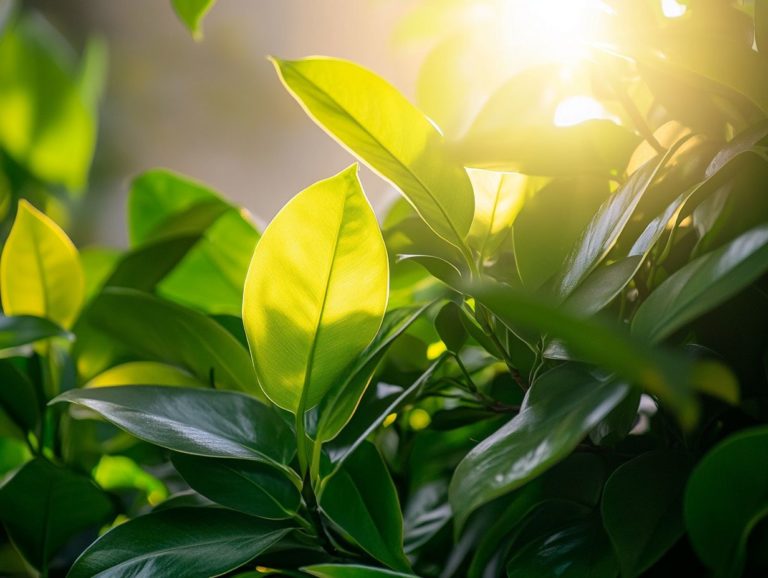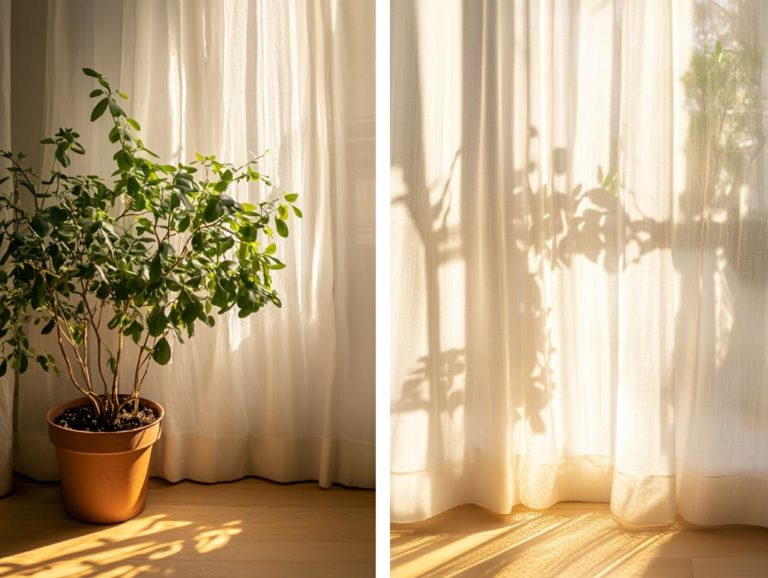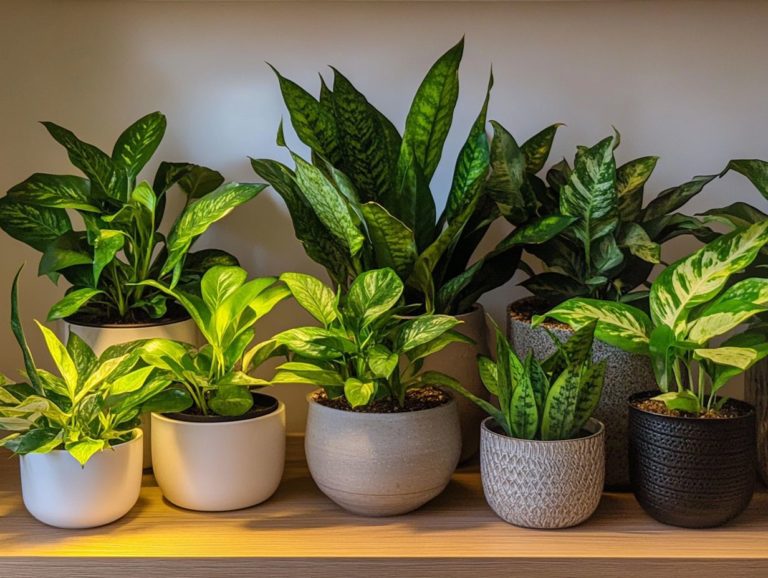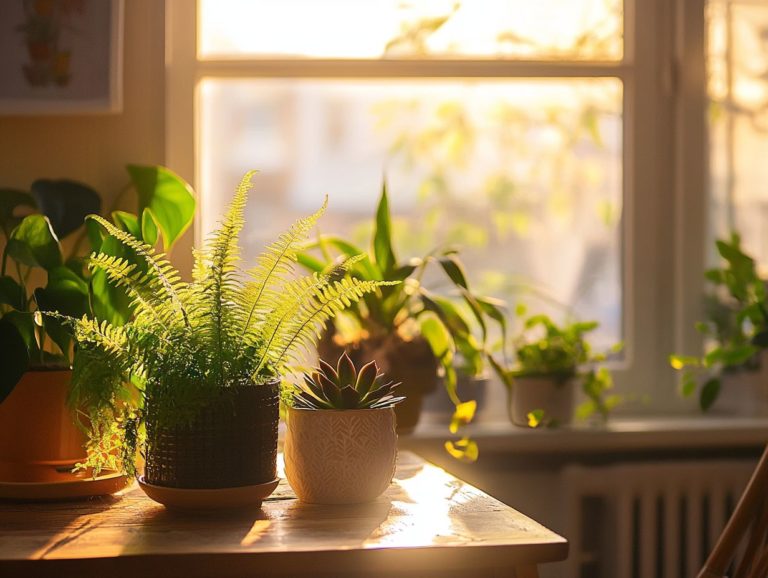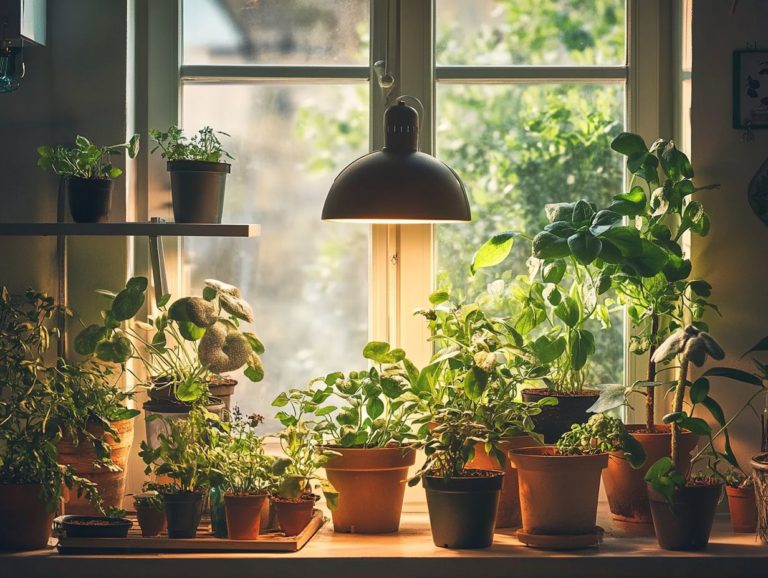How to Use Light Meters for Plants
Light is vital for plant growth. It impacts everything from photosynthesis to flowering.
By understanding how to measure and optimize light levels using a light meter, you can significantly enhance your gardening experience. This is true whether you’re a seasoned gardener or a passionate indoor plant enthusiast.
This article delves into the essentials of light for plants, introduces you to various types of light meters including illuminance meters, and provides a step-by-step guide on using them effectively.
You ll discover how to interpret your readings and troubleshoot common issues, ensuring your plants thrive under the best conditions.
Whether you re nurturing houseplants or managing a garden, mastering light measurement will unlock your plants’ full potential. This knowledge allows them to flourish like never before under the right light sources.
Contents
- Key Takeaways:
- Understanding Light and Plants
- Types of Light Meters
- How to Use a Light Meter
- Interpreting Light Meter Readings
- Troubleshooting Common Issues
- Maximizing Plant Growth with Light Meters
- Frequently Asked Questions
- What is a light meter and why is it important for plants?
- How do I choose the right light meter for my plants?
- How do I use a light meter to measure light for indoor plants?
- Can I use a light meter for outdoor plants?
- How often should I use a light meter for my plants?
- Are there any other factors besides light that can affect plant growth?
Key Takeaways:
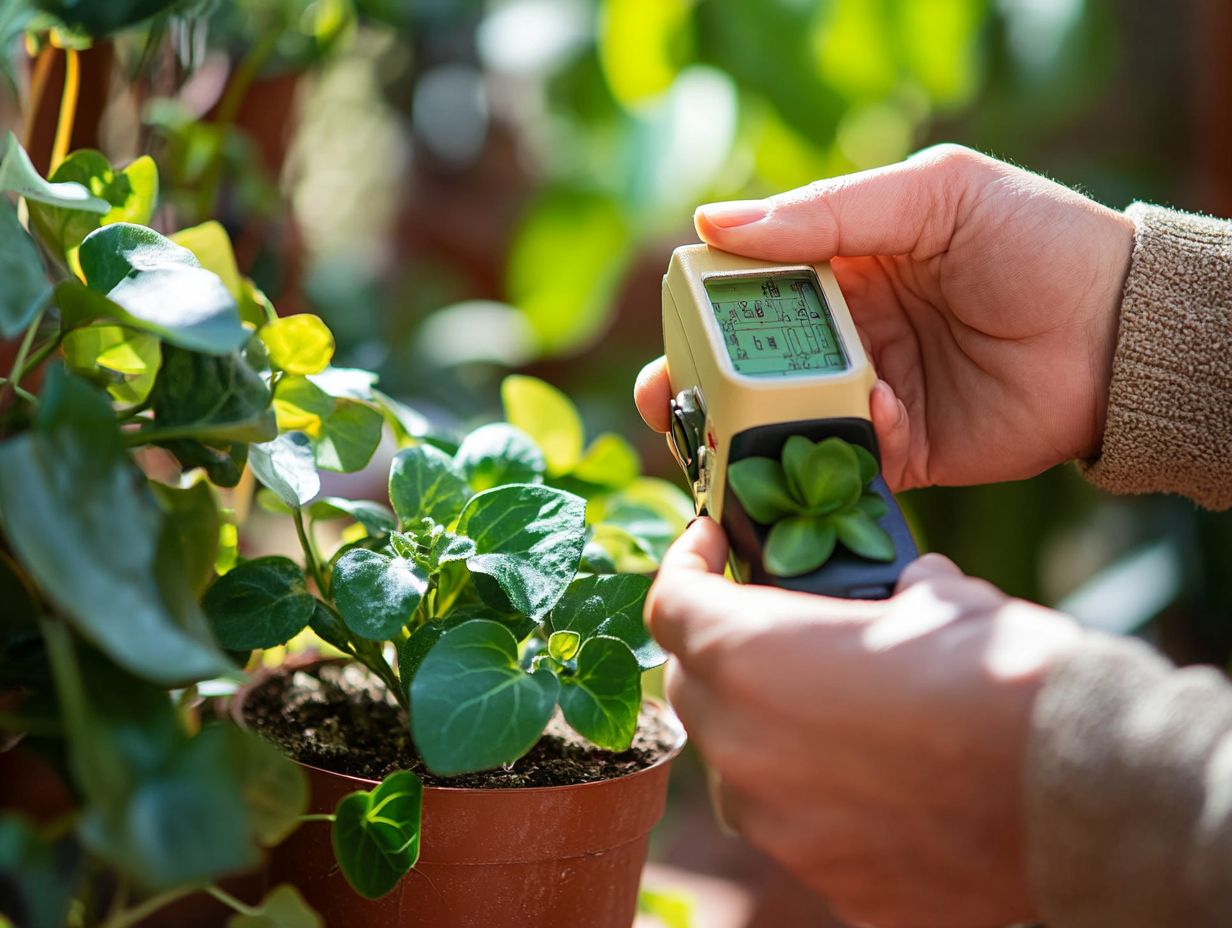
- Light fuels plant growth. Different plants need varying amounts of light.
- There are various light meters for measuring light levels, each with pros and cons.
- Follow a clear guide to use a light meter effectively and understand your readings.
Understanding Light and Plants
Understanding the intricate relationship between light and plants is crucial for horticultural success. This is especially true when you consider factors like plant growth, light intensity, and the specific lighting preferences of different species.
This relationship plays a pivotal role in both indoor and outdoor environments. Here, sunlight exposure can significantly impact growth rates and overall health. Striking an optimal balance between natural and artificial lighting is essential, particularly for tropical plants and houseplants.
By ensuring that each plant receives the right light conditions, you create an environment where they can truly thrive. This enables them to benefit from both high light and low light conditions.
Importance of Light for Plant Growth
Light is essential for your plants growth. It influences vital processes like photosynthesis and overall health. The intensity and quality of light can be gauged using various techniques, such as Photosynthetically Active Radiation (PAR) analysis and Photosynthetic Photon Flux Density (PPFD) measurement.
Different wavelengths of light affect plant development in unique ways. For instance, blue light promotes vegetative growth, while red light plays a crucial role in flowering and fruiting. This variation highlights how plants respond to light spectrum manipulation, showcasing their adaptability.
Light intensity is critical for photosynthesis. If there isn t enough light, it can stifle this essential process, leading to stunted growth and reduced yields. If you’re contending with fluctuating natural light availability, artificial lighting can be a game changer. It allows you to boost photosynthetic activity, ensuring your plants thrive under optimal light conditions, no matter what s happening outside.
Types of Light Meters
Grasping the various types of light meters at your disposal is essential for evaluating light conditions accurately. Whether you opt for traditional physical light meters or cutting-edge digital light meter apps, you’ll find a range of functionalities designed to enhance your experience.
These tools can assist you with illuminance measurement, light calibration, and data tracking. All contribute to optimal plant care in both commercial operations and home gardens.
Unlock your garden’s potential! Mastering light measurement can transform your plants’ health and growth.
Overview of Different Light Meters
Different light meters, such as illuminance meters, digital light meters, and physical light meters, provide a range of methodologies for measuring light conditions. It’s essential to choose the right tool based on your specific plant lighting needs.
Each type serves a distinct purpose. For example, illuminance meters are highly valued for their precision in assessing ambient light. Digital light meters offer quick, on-the-go readings perfect for photographers or indoor gardeners. Additionally, understanding how to use moisture meters for plants can enhance your indoor gardening experience.
Physical light meters, though more traditional, excel in delivering consistent readings over time. They cater to those who require detailed analysis. For those interested in learning how to use a light meter at home, many smartphones now come equipped with sensors that can measure light intensity, offering a convenient alternative for casual users or hobbyists.
Smartphone apps can be helpful, but dedicated light meters typically provide greater accuracy and reliability, especially in professional settings where precision is paramount.
How to Use a Light Meter
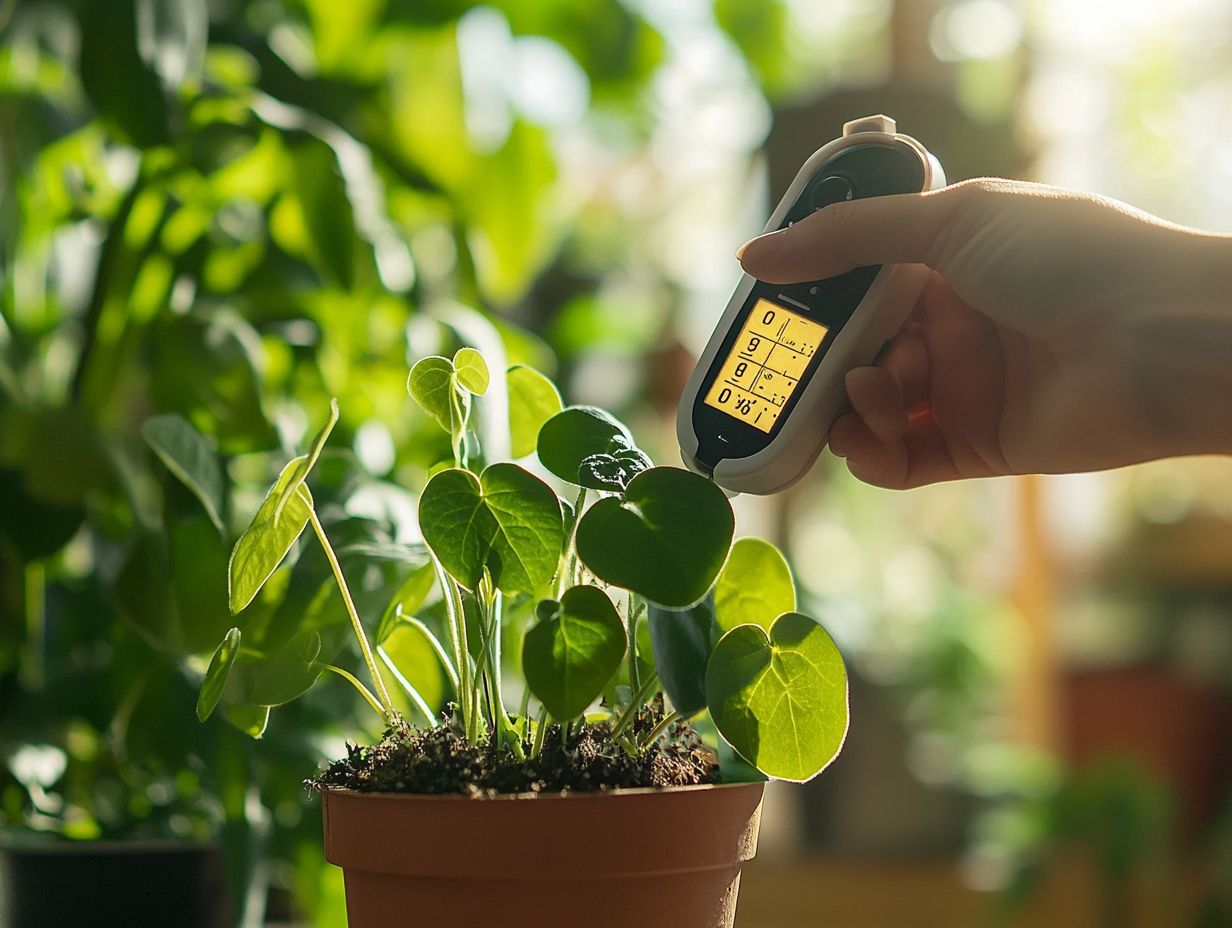
To use a light meter effectively, you need to understand light calibration techniques, measurement accuracy, and proper usage protocols. Knowing these will help your plants thrive!
Step-by-Step Guide
To achieve precise measurements, follow this comprehensive guide on using a light meter. This includes setting the device to the appropriate light settings and understanding units of measurement like lux and foot-candles.
- Start by selecting the right mode on your light meter, depending on whether you re measuring ambient light or incident light.
- Next, calibrate the device according to the manufacturer’s instructions to ensure it operates effectively, focusing on measurement accuracy.
- Once calibrated, position the light meter at your desired location, making sure it faces the light source directly for accurate exposure readings.
- As you take measurements in various environments indoors, outdoors, or near reflective surfaces watch your settings and adjust for the different lighting conditions.
- By consistently following this methodology, you ll achieve reliable light readings that enhance the accuracy of your measurements.
Interpreting Light Meter Readings
Understanding light meter readings, including PPFD measurements and light intensity values, is crucial. This ensures your plants receive the right quality and quantity of light for optimal growth and development.
By grasping these readings, you can make informed decisions that enhance your plants’ health and vitality.
What the Numbers Mean for Your Plants
Understanding the numbers from your light meter readings is essential for assessing light intensity and quality. These factors can fluctuate between low and high light scenarios, directly influencing the health of your plants.
Different plants have unique light requirements. For instance, leafy greens thrive in bright, direct sunlight, while others prefer the gentler embrace of filtered, indirect light. Leafy greens usually flourish with a PAR level of around 200 to 400 mol/m /s. Fruiting plants typically require a range of 400 to 800 mol/m /s for optimal growth.
By using the light meter to assess these specific readings, you can make adjustments to your setup, ensuring the light quality remains within the ideal spectrum. This proactive approach fosters robust growth and enhances your plants’ overall vitality. Additionally, it’s important to monitor light exposure for healthy plants, resulting in healthier yields.
Troubleshooting Common Issues
Troubleshooting common issues with your light meter is crucial for achieving accurate readings. Addressing these concerns ensures that your plants receive the optimal light conditions they require to thrive.
Check your meter regularly, and don’t hesitate to experiment with your settings. Start measuring your plants’ light conditions today for better growth results!
Tips for Accurate Readings and Troubleshooting
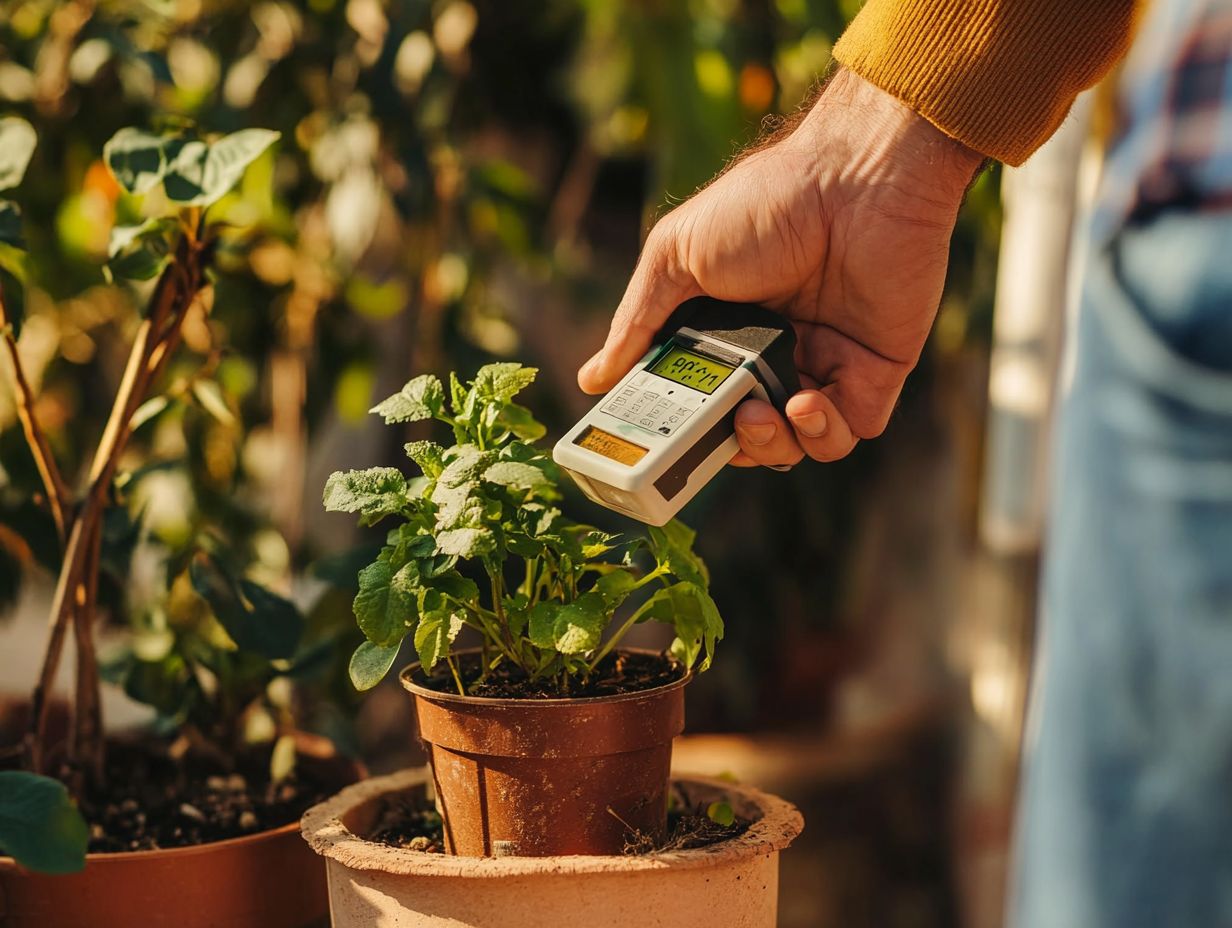
To obtain accurate readings from your light meter, consider these essential tips that address common troubleshooting scenarios. These tips highlight the importance of regular light calibration, which means adjusting your meter to ensure it’s measuring correctly, to maintain measurement accuracy and ensure your plants receive optimal light exposure.
Familiarizing yourself with your device’s features and limitations will help you see amazing improvements in its performance. Start by ensuring that the meter is clean; any dirt or grime can obstruct the light sensors, resulting in unreliable measurements.
Pay attention to the environment in which you re taking readings. Varying light conditions can impact your results. Regularly check the battery status to guarantee that your meter operates at its best.
Calibrating your light meter at specified intervals every six months or after significant temperature changes is crucial. Don t wait calibrate your light meter regularly to get the best results!
By following these practices, you will not only improve accuracy but also extend the lifespan of your meter.
Maximizing Plant Growth with Light Meters
Maximizing plant growth with light meters requires a deep understanding of how to adjust light levels and quality. This understanding is essential to meet the unique lighting needs of different plants. By doing so, you enhance their overall health and productivity, fostering an environment where they can truly thrive.
Optimizing Light Levels for Different Plants
Optimizing light levels for different plants is crucial for their growth. It begins with understanding the unique lighting preferences of each species, whether you re tending to tropical beauties or beloved houseplants that may require specific grow lights.
Recognizing that some plants bask in bright, direct sunlight while others thrive in the gentle embrace of indirect light makes the task more manageable. For example, succulents and cacti love full sun exposure, perfectly at home on sunny windowsills. In contrast, ferns and some houseplants prefer the cozy feel of lower light environments.
As you navigate the various growth stages, remember the lighting needs of seedlings differ significantly from mature plants. Indoor gardeners should also adjust light intensity and duration with the changing seasons, unlike outdoor plants that naturally acclimate to their environment.
Grasping these nuances enables you to cultivate a lush, vibrant space, whether at home or in your garden.
Frequently Asked Questions
What is a light meter and why is it important for plants?
A light meter measures the brightness or intensity of light in a given area. This device is critical for plants as they require a certain amount of light for photosynthesis, growth, and overall health. A light meter helps determine if a plant is receiving enough light or if it needs to be moved.
How do I choose the right light meter for my plants?
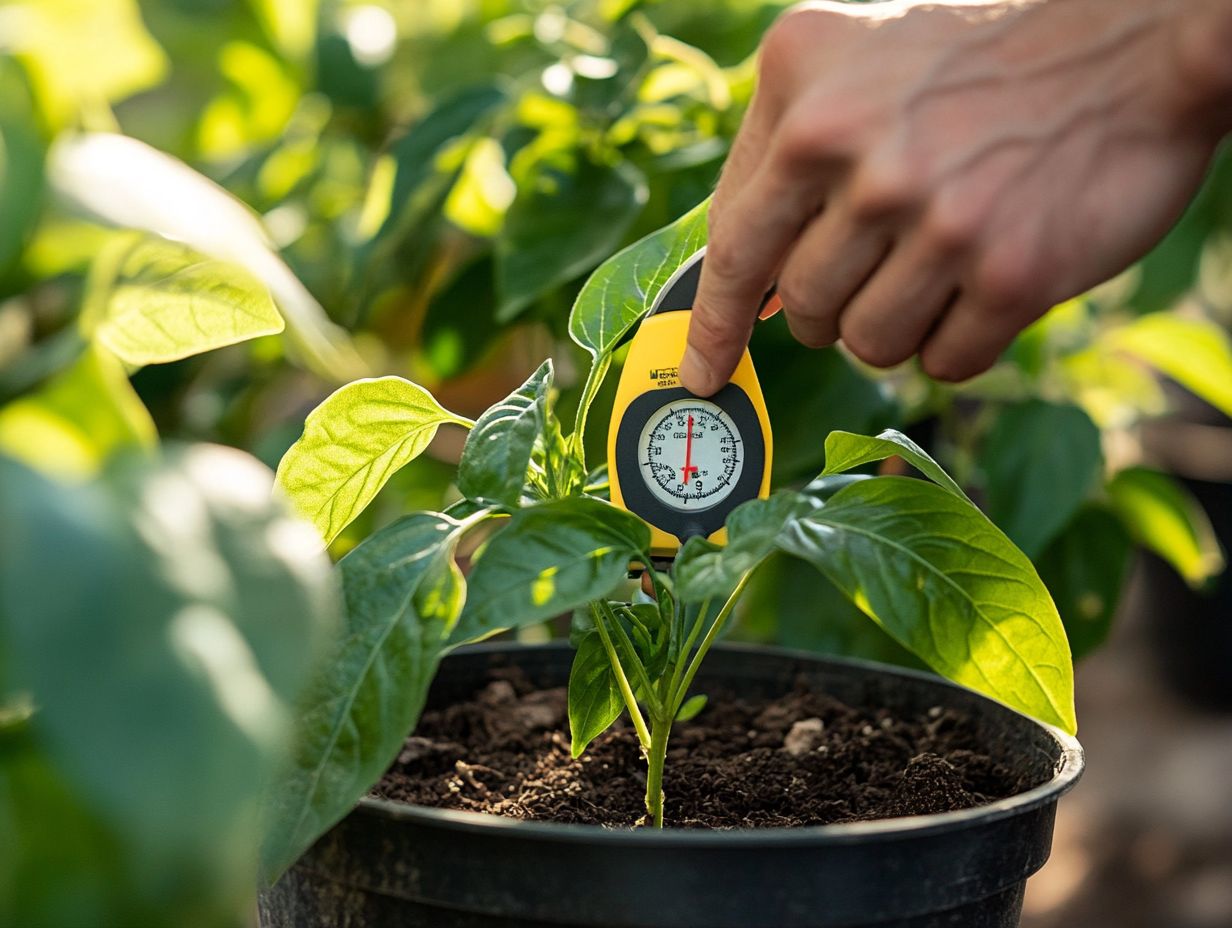
When choosing a light meter, consider the type of light your plants need (natural or artificial), the size of the area you want to measure, and your budget. There are various types available, including handheld, digital, and smartphone apps. Read reviews and compare features before making a purchase.
How do I use a light meter to measure light for indoor plants?
To use a light meter for indoor plants, make sure the area to measure is free from direct light sources (like windows or lamps). Turn on the light meter and hold it at the same level as your plant’s leaves. Take multiple readings in different areas to get an average measurement. Indoor plants typically require 200-800 foot-candles of light for optimal growth.
Can I use a light meter for outdoor plants?
Yes, light meters can also be used for outdoor plants. Measure the light levels at the same time of day when your plants receive the most light. Different plants have different light requirements, so research the specific needs of your outdoor plants before using a light meter.
How often should I use a light meter for my plants?
Use a light meter at least once a week. This is especially important if your plants show changes in growth or health.
A light meter helps you check if your plants receive enough light. You can also track light levels throughout the seasons.
Are there any other factors besides light that can affect plant growth?
Yes, water, temperature, and nutrients also impact plant growth. Balancing these factors is key to thriving plants!
While a light meter helps with light levels, keep an eye on water and temperature too!

